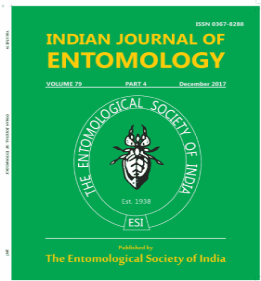Management of Rodent Pests in Wheat Sown under Different Tillage Systems
DOI:
https://doi.org/10.55446/IJE.2022.669Keywords:
Bromadialone, burrow baiting, cut tillers, maize residue, paper bait, rodents, rodenticide, tillage, wheat crop, zinc phosphideAbstract
Investigation to manage rodent pests in wheat crop sown with different tillage methods was conducted. The results revealed maximum efficacy in the form of control success (%) on plain bait consumption and burrow count basis with conventional (92.30) followed by zero tillage (84.74) and maize residue tillage (74.38). In these, rodenticide treatments with double burrow baiting was followed by single paper baiting. Lesser % cut tillers (0.39-0.53) and damage 9.56-15.71 kg/ 0.4 ha were observed in these. Burrow count in maize residue and zero tillage was 2.15 and 1.60x more than conventional tillage. Thus, rodenticide treatments with double burrow baiting at vegetative stage in December (bromadialone followed by zinc phosphide at 15 days interval) along with paper baiting (bromadialone) at reproductive stage (end February to 1st week of March) can be recommended against rodents in wheat crop to get higher economic returns (Rs.452.36-556.81/ 0.4 ha).
Downloads
Metrics
Downloads
Published
How to Cite
Issue
Section
References
Anonymous 2021. Wheat crop. Package of practices for crops of Punjab-Rabi, Punjab Agricultural University, Ludhiana. pp. 1-21.
Anonymous 2015a. Management of rodents and birds. Package of practices for crops of Punjab-Rabi, Punjab Agricultural University, Ludhiana. pp.110-113.
Anonymous 2015b. Wheat crop. Package of practices for crops of Punjab-Rabi, Punjab Agricultural University, Ludhiana. pp. 1-18.
Collins H P, Rasmussen P E, Douglas C L. 1992. Crop rotation and residue management effects on soil carbon and microbial dynamics. Soil Science Society of America Journal 56: 783-788.
Filipovic D, Silvio K, Zlatko G O, Robert Z, Djuro B. 2006. The possibility of fuel saving and reduction of CO2 emission in the soil tillage in Croatia. Agriculture Ecosystem and Environment 115(1-4): 290-294.
Hussain S, Khaliq A, Matlob A, Fahad S, Tanveer A. 2015. Interference and economic threshold level of little seed canary grass in wheat under different sowing times. Environmental Science and Research 22: 441-449.
Jensen E S. 1997. Nitrogen immobilization and mineralization during initial decomposition of N labeled pea and barley residues. Biology and Fertility of Soils 24: 39-44.
Kaur N, Singla N, Singh R. 2018. Efficacy of rodenticide bait application for rodent pest management in potato crop. Journal of Entomology and Zoology Studies 6(2): 2149-2152.
Khaliq A, Matloob A, Hussain A, Hussain S, Aslam F, Zamir S I, Chattha M U. 2015. Wheat residue management options affect crop productivity, weed growth and soil properties in direct seeded fine aromatic rice. Clean Soil Air and Water 43(8): 1259-1265.
Khaliq A, Gondal M R, Matloob A, Ullah E, Hussain S, Murtaza M. 2013. Chemical weed control in wheat under different rice residue management options. Pakistan Journal of Weed Science and Research 19: 1-14.
Kocher D K, Kaur R. 2007. Survey of rodent damage in sugarcane fields of Punjab and its control by rodenticidal baiting. Pestology 31(12): 40-43.
Mandal K G, Mishra A K, Hati K M, Bandyopadhyay S, Ghosh P K, Mohanty M. 2004. Rice residue management options and effects on soil properties and crop productivity. Journal of Food Agriculture and Environment 2: 224-231.
Sharma S N, Bohra J S, Singh P K Srivastava R K. 2002. Effect of tillage and mechanization on production potential of rice (Oryza sativa)-wheat (Triticum aestivum) cropping system. Indian Journal of Agronomy 47(3): 305-310.
Sidhu B S, Beri V. 2005. Experience with managing rice residues in intensive rice-wheat cropping system in Punjab. Conservation agriculture status and prospects. Abrol I P, Gupta R K, Malik R K (eds.), Centre for Advancement of Sustainable Agriculture (CASA), New Delhi, India. pp 55-63.
Singh P K, Prakash V, Srinivas A K, Srivastva R K. 2008. Effect of tillage management on energy-use efficiency and economics of soybean (Glycine max) based cropping systems under the rainfed conditions in North-West Himalayan region. Soil and Tillage Research 100: 78-82.
Singh R, Singla N, Kaur N. 2017. Determination of method and timings of rodent control in direct seeded and transplanted basmati rice crops. The Bioscan 12(2): 701-705.
Singh Y, Singh B, Timsina J. 2000. Crop residue management for nutrient cycling and improving soil productivity in rice-based cropping systems in the tropics. Advances of Agronomy 85: 269-407.
Singla N, Babbar B. 2012. Critical timings of rodenticide bait application for controlling rodents in sugarcane crop grown in situations like Punjab. Indian Journal of Sugar Technology 14(1):76-82.
Singla N, Babbar B 2010. Rodent damage and infestation in wheat and rice crop fields: District wise analysis in Punjab state. Indian Journal of Ecology 307(2): 88-184.
TimsinaJ, Connor D J 2001. Productivity and management of rice-wheat cropping systems: Issues and challenges. Field Crop Research 69: 93-132.
Uri N D. 1999. Perception on the use of no-till farming in production agriculture in the United States: an analysis of survey results. Agriculture, Ecosystem and Environment 77(3): 263-266.
















